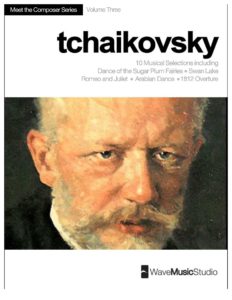Table of Contents
Come join us now, and enjoy playing your beloved music and browse through great scores of every level and styles!
Can’t find the songbook you’re looking for? Please, email us at: sheetmusiclibrarypdf@gmail.com We’d like to help you!
Tchaikovsky Children’s Album Op. 39 sheet music, Noten, partitura, spartiti, partition, 楽譜
Please, subscribe to our Library.
If you are already a subscriber, please, check our NEW SCORES’ page every month for new sheet music. THANK YOU!

Best Sheet Music download from our Library.
Browse in the Library:
Or browse in the categories menus & download the Library Catalog PDF:
Beyond Nursery Rhymes: Tchaikovsky’s “Children’s Album” Op. 39 – A World of Wonder in Miniature
Pyotr Ilyich Tchaikovsky. The name conjures soaring symphonies, heart-wrenching concertos, and the sumptuous ballets that define the Romantic era – Swan Lake, Sleeping Beauty, The Nutcracker. Yet, nestled within this titanic output, often overshadowed but radiating its own unique charm and profound significance, lies a gem of intimate scale: the “Children’s Album” Op. 39 (Russian: Детский альбом). Composed in 1878, this collection of 24 short piano pieces is far more than a simple pedagogical tool; it is a meticulously crafted window into a child’s world, a testament to Tchaikovsky’s melodic genius and empathetic heart, and a foundational cornerstone of the piano repertoire for young musicians.
Origins and Inspiration: A Gift from the Heart
The year 1878 found Tchaikovsky recovering from personal turmoil, including the disastrous end of his brief marriage and the subsequent emotional breakdown. Seeking solace, he spent time at his sister Alexandra Davydova’s estate in Kamenka, Ukraine, surrounded by her large family, particularly his young nephew, Vladimir (affectionately known as “Bobyk”). Observing Bobyk’s early piano lessons proved transformative. Tchaikovsky was struck by the dull, mechanical exercises children were typically subjected to. He recalled the joy and inspiration he himself had found in Schumann’s Kinderszenen (Scenes from Childhood) as a boy. This sparked a desire: to create a set of pieces that were technically accessible for young hands, yet brimming with genuine musicality, vivid imagery, and emotional resonance – music that would engage a child’s imagination, not just train their fingers.
Dedicated to Bobyk, “with the hope that he will remember me when he is grown up,” the Children’s Album was born from this profound empathy and artistic generosity. Tchaikovsky didn’t condescend; he aimed to elevate children’s music to the level of art.
A Kaleidoscope of Childhood: Exploring the Miniatures
Organized not as a strict suite but as a delightful anthology, Op. 39 traverses a remarkably diverse landscape of moods, scenes, and characters, each piece a perfectly formed miniature. Let’s journey through some of its highlights:
- The Intimate Sphere: The album opens gently with “Morning Prayer” (Утренняя молитва), a serene chorale setting a tone of quiet contemplation. Pieces like “Winter Morning” (Зимнее утро) evoke chilly stillness with delicate, sparse textures, while “The Sick Doll” (Болезнь куклы) and its companion “The Doll’s Funeral” (Похороны куклы) explore poignant sadness with touching simplicity, demonstrating Tchaikovsky’s uncanny ability to convey deep emotion with sparse means. “The New Doll” (Новая кукла), in contrast, bursts with infectious, skipping joy.
- Rhythmic Vitality and Dance: Tchaikovsky, the master ballet composer, naturally infuses the album with dance. The “Waltz” (Вальс) is graceful and elegant, a miniature ballroom scene. The “Mazurka” (Мазурка) captures the characteristic Polish rhythm with charm. “Polka” (Полька) is brisk and playful. “Italian Song” (Итальянская песенка) likely reflects the lively street music Tchaikovsky encountered during his travels, full of sunny energy.
- Storytelling and Character: Several pieces are musical portraits or narratives. “Nanny’s Tale” (Нянина сказка) has a slightly mysterious, recitative-like quality, suggesting the unfolding of a story. “Baba-Yaga” (Баба-Яга) is a brilliant, terrifying depiction of the famous Slavic witch, with dissonant chords and wild, swirling passages evoking her flight in the mortar. The “March of the Wooden Soldiers” (Марш деревянных солдатиков) is a perennial favorite, its crisp, precise rhythms and catchy melody perfectly capturing the stiff, toy-like march.
- Folk Influences: Tchaikovsky often drew from Russian folk sources. “Russian Song” (Русская песенка) is a beautiful, melancholic melody over a drone bass, steeped in national character. “A Man Plays the Harmonica” (Мужик на гармонике играет) mimics the wheezy, repetitive sound of the folk instrument.
- Musical Journeys: “The Organ-Grinder Sings” (Шарманщик поет) evokes the nostalgic, slightly plaintive sound of a street organ. “Old French Song” (Старинная французская песенка) offers a gentle, lyrical melody with a touch of antique grace. “German Song” (Немецкая песенка) and “Neapolitan Song” (Неаполитанская песенка) further showcase Tchaikovsky’s knack for capturing national flavors in miniature.
- Playful Escapades: “Game of Horse” (Игра в лошадки) suggests the rhythmic clatter of toy horses with repetitive, driving figures. “Sweet Dreams” (Сладкая грёза) provides a moment of tender reverie before the lively conclusion.
Artistry in Simplicity: Musical Craftsmanship
The genius of the Children’s Album lies in its deceptive simplicity. Tchaikovsky achieves maximum expressiveness with minimal technical demands (relative to his concert works):
- Unforgettable Melodies: Each piece is built around a strong, singable, and memorable melody. These tunes are the heart and soul of the album, instantly capturing the ear and the imagination.
- Harmonic Nuance: Even within basic harmonic frameworks, Tchaikovsky employs subtle shifts and poignant chords (like the expressive harmonies in “The Sick Doll” or the surprising turns in “Baba-Yaga”) that add depth and color far beyond typical beginner pieces.
- Evocative Textures: He uses the piano resourcefully – from the sparse, open fifths suggesting winter cold, to the thick chords of the funeral march, the delicate tracery of the waltz, or the percussive staccatos of the march.
- Characterful Rhythm: Rhythmic vitality is key, whether in the precise march, the lilting waltz, the energetic polka, or the improvisatory feel of the harmonica piece.
- Emotional Range: Crucially, Tchaikovsky doesn’t shy away from the full spectrum of a child’s inner world. Joy, excitement, curiosity, contentment, sadness, fear, and wonder are all given voice with sincerity and respect.
Pedagogical Power and Enduring Legacy
Tchaikovsky achieved his pedagogical goal spectacularly. The Children’s Album quickly became, and remains, an indispensable part of piano education worldwide. Its pieces offer:
- Technical Foundation: It introduces essential skills – scales, arpeggios, chords, articulation (staccato, legato), dynamic control, basic polyphony – within engaging musical contexts.
- Musicality Development: It teaches phrasing, expression, tone production, and the vital connection between feeling and sound from the very beginning.
- Stimulating Imagination: The vivid titles and inherent musical imagery spark creativity and encourage young players to think beyond the notes.
- Building Confidence: Mastering these beautiful, recognizable pieces provides immense satisfaction and builds confidence for tackling more complex works.
Beyond pedagogy, Op. 39 stands as a complete artistic statement. It proved that music for children could be serious art, devoid of condescension. It paved the way for other great composers to create significant children’s collections (like Prokofiev’s Musiques d’enfants Op. 65 or Kabalevsky’s pieces for young pianists). Its melodies are universally beloved, its emotional honesty timeless.
A Treasure for All Ages
Tchaikovsky’s Children’s Album Op. 39 is a masterpiece of miniature form. It transcends its original purpose as instructional material to become a captivating musical journey into childhood itself. It reveals Tchaikovsky not only as the grand symphonist but as a composer of exquisite sensitivity and profound understanding of the young heart and mind. Within these 24 short pieces lies a universe: playful and profound, simple yet sophisticated, deeply Russian yet universally relatable. It is music that nurtures the budding pianist, delights the listening child, and continues to enchant audiences of all ages with its enduring charm, exquisite craftsmanship, and pure, heartfelt expression. It is a testament to the power of art to find the extraordinary within the seemingly small, a precious gift from a great composer to children, and indeed, to the world.
Browse in the Library:
Or browse in the categories menus & download the Library Catalog PDF:
